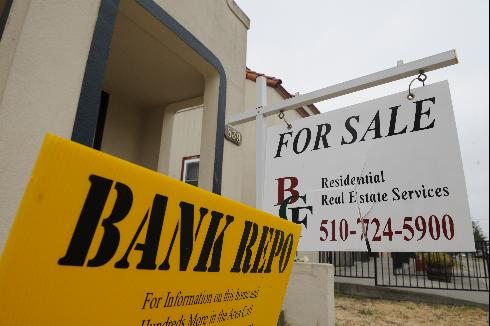Town’s bankruptcy filing may be a bad sign for other cities
Edward Iwata
USA Today

The credit crunch has really hit home in Vallejo, Calif., population 117,000. It’s seeking bankruptcy protection after failing to win concessions from police and fire unions.
VALLEJO, Calif. — His roots run deep here. As a kid, 55-year-old contractor Randy Golovich played baseball, worked at the corner gas station, chased girls at the local soda counter. He helped his late father, a foreman at the old Mare Island Naval Shipyard, rebuild the family house.
The chummy, fast-talking Golovich also earned a good living in this waterfront suburb an hour’s drive northeast of San Francisco. As Vallejo grew, his contracting business, Randu Originals Ceramic Tile, hauled in millions of dollars in sales over the years. The jobs kept coming. The economy kept booming. Traffic filled Tennessee Street outside his showroom.
Not now. The mortgage crisis, the limping economy and a recent bankruptcy filing by Vallejo — the first municipality to do so since Desert Hot Springs, Calif., in 2001 — have hobbled this town of 120,000. Golovich’s business is hurting. Jobs and phone calls from customers have dried up. He’s cut his staff and fleet of trucks in half, to six employees and four vehicles.
Golovich also could lose his home. When the interest rate on his $500,000 adjustable-rate mortgage rose to 10% from 7%, his monthly payment shot up to $4,000, and he could not afford it. Hoping to ward off foreclosure, he and counselors at the non-profit Vallejo Neighborhood Housing Services are working with his lender on a new payment plan.
Despite his woes, Golovich is hopeful.
“Driving through this town is depressing. It tears your heart out,” he says. “But Vallejo‘s going to come back big, and when it does, I’m going to be the last tile store standing. I’ve just got to hold on and keep my house.”
Vallejo‘s closely watched Chapter 9 bankruptcy filing in federal court in Sacramento may be a warning sign of dangers that could befall other cash-strapped municipalities.
Bankruptcy Judge Michael McManus will hear arguments starting Wednesday on whether to let the case go forward.
Vallejo‘s attorneys say the city faces a $17 million deficit and cutbacks in public services for the fiscal year started July 1. The city’s police and fire department unions contend that Vallejo is not insolvent but that city officials are trying to dodge labor agreements and obligations to union members and retirees.
Vallejo‘s financial woes aren’t unique, according to municipal-bond analysts and bankruptcy attorneys.
A convergence of forces — the housing bust and credit crunch, tax revenue shortfalls, pension fund costs for public employees and the shaky economy and financial markets — are making it increasingly hard for municipalities to balance their budgets.
“We’re seeing a lot of governments around the country entering a period of flat or declining revenues,” says Gabriel Petek, a municipal-bond analyst at Standard & Poor’s. “I don’t expect this to turn into an avalanche, but there may be isolated instances of distress.”
Defaults’ damage rises
Across the USA, 59 bond issues of $1.2 billion have defaulted this year, according to Richard Lehmann, publisher of Distressed Debt Securities newsletter and president of Income Securities Advisors, an investment research firm. The dollar total is almost higher than the past two years combined, he says.
Over the past 20 years or so, 1,100 municipal issuers defaulted on their debt, according to Standard & Poor’s. Orange County, Calif., endured the largest municipal bankruptcy in U.S. history in 1994 after suffering $1.6 billion in investment losses.
Despite the defaults, Petek observes that most local governments in recent years have adopted strong financial-management practices, such as building up cash reserves that will cushion their municipalities during economic slumps.
Vallejo‘s $119 million in bonds in the bankruptcy case aren’t in danger of defaulting, Lehmann believes. Most of the city’s debt is backed by bond insurers or letters of credit, he says.
Even amid harsh economic times, the majority of municipalities manage to avoid bankruptcy, says Chris Hoene, director of policy and research at the National League of Cities.
Typically, states have stepped in to oversee municipalities such as New York City, Detroit and Camden, N.J., that were on the verge of bankruptcy in the past.
“I don’t think we’re going to see a rash of municipal bankruptcies nationwide,” Hoene says.
But Vallejo may be different. California cannot take receivership of its municipalities. The strong anti-tax movement and laws in the Golden State limit local government bodies from raising tax dollars. And Vallejo‘s high labor costs for its public employees make it tougher to deal with its budget shortfall, Hoene says.
Fading opportunities
Long before its bankruptcy filing, Vallejo had been an economic haven and a thriving bedroom community known as the City of Opportunity.
Through the 1980s, thousands of commuters were enticed by the town’s affordable homes, the fresh bay breezes, the nearby wine country of Napa Valley. A Six Flags theme park and the naval shipyard, which built hundreds of warships and nuclear submarines since the 19th century, anchored the local economy.
But after the shipyard closed 10 years ago, the economy sputtered and, some say, never fully recovered.
Then the mortgage crisis struck last year. The weak housing market throttled Vallejo‘s revenue growth to 3%, while labor costs for the city’s police officers and firemen rose 11%.
Vallejo has cut 87 jobs and slashed funding for parks, a library, a senior citizens’ center and other public services. City and labor leaders agreed this year to temporarily roll back union salaries 6%, but it wasn’t enough to hold off the bankruptcy filing.
Meanwhile, the housing crisis seems to worsen in some regions.
According to RealtyTrac, an online foreclosure research firm, foreclosures in California have doubled to 381,000 this year compared with the same period in 2007. In Vallejo, foreclosures rose 61% to 2,900 in the first six months of this year, compared with the same time in 2007.
Carol Hardy, interim executive director of Vallejo Neighborhood Housing Services, says that phone calls from financially strapped homeowners in Vallejo have poured in by the hundreds recently.
Many have received foreclosure warnings from lenders, or they’re having trouble making higher mortgage payments when their adjustable interest rates rise.
“They were refinancing their homes like ATMs,” Hardy says. “They weren’t thinking two steps ahead, to what happens when their loan readjusts.”
While residents wrestle with possible foreclosure, the city and its unions — the Vallejo Police Officers Association, the International Association of Fire Fighters and the International Brotherhood of Electrical Workers — gird for legal battle this week.
In court papers, the unions contend that Vallejo is not bankrupt, that it still is paying bondholders and that it had $136 million in cash when it filed for bankruptcy. The filing, the unions allege, is a ploy to force the unions to renegotiate their contracts.
Harvey M. Rose Associates, a San Francisco accounting firm hired by the unions, states in a court filing that Vallejo could balance its budget and build a surplus of millions of dollars by slashing costs, selling city land and increasing fees and assessments.
Unlike similar nearby towns, such as Richmond, that boast more diverse and thriving economies, Vallejo did not rejuvenate its economy and tax base enough to ward off financial woes, says Dean Gloster, an attorney at Farella Braun & Martel, who represents the unions.
“The truth is that Vallejo has been in serious financial trouble for over a decade,” he says. “It’s a very poorly managed city.”
Vallejo officials say in court filings that the mortgage meltdown and high labor salaries and benefits, rising to $79 million in the current fiscal year, have forced the city to file for bankruptcy. The city, they argue, cannot balance its budget unless the unions make concessions.
Marc Levinson, a lawyer at Orrick Herrington & Sutcliffe, who represents Vallejo, denies that the city is sitting on $136 million in cash and assets, or that Vallejo “deliberately manufactured bankruptcy to break its labor contracts.” He contends that the Rose report is flawed.
Says Levinson, “The city can’t afford to pay the contracts. The city has cut to the bone. There is nowhere else to go.”
A tough fight ahead
If similar bankruptcy cases are any indication, the unions face a tough legal fight, according to Bruce Bennett, an attorney at Hennigan Bennett & Dorman, who worked on the Orange County bankruptcy and is not involved in Vallejo‘s case.
“There were extensive negotiations prior to the case,” says Bennett, who read the key bankruptcy filings, “and it does not appear the city has misrepresented its actual, current financial condition.”
Beyond the filing, Vallejo‘s economy — mostly retailing, business services and manufacturing — could get a boost from development projects and a $300 million cancer research center planned by Touro Universityon Mare Island.
Back on Tennessee Street, the quiet main road from the highway to Mare Island, contractor Golovich waves at friends and business people driving by. The economy, he believes, will start rumbling soon.
“This street is going to be booming again, I’m certain of it,” he says. “You can see the traffic picking up now.”









